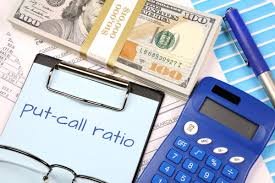Last Updated on August 4, 2024 by Asfa Rasheed
An options chain contains a wealth of information for F&O traders who want to understand the contract they’re trading in and the overall market sentiment. In addition to crucial details like the strike price, bid and ask quantities, last traded price, volume and implied volatility, an options chain also shows you the open interest (OI) for each derivative contract of an asset.
In simple terms, the open interest tells you the number of put and call options currently open in the market. This data is vital for computing the options put call ratio (PCR), which, in turn, can help you prepare for potential trend reversals.
Curious about how the PCR is tied to trend reversal analysis? In this article, we delve into the details and give you the answers and show you some practical tools by Samco, that can help you calculate options put call ratio (PCR).
Table of Contents
What is the Put Call Ratio (PCR)?
The options put call ratio is simply the total number of put options traded in the market divided by the total number of call options traded. This total is represented by the open interest.
When you view the options chain for a derivative, you can find the OI for calls on the left end of the grid and the OI for puts on the right end. To find the options put call ratio for the contract you’re looking at, scroll down to find the total OI for both types of options. Then, divide the put options OI by the call options OI.
The formula for the options put call ratio is as follows:
PCR = Put Open Interest ÷ Call Open Interest
For example, say the total OI for the puts of an asset is 48,80,416 and the total OI for its calls is 43,18,402. This gives us an options put call ratio of 1.13.
Interpreting the Put Call Ratio
While it’s essential to know how the options put call ratio is calculated, it’s more important to know how to interpret the ratio. This is because the PCR is readily available on many online platforms, so you can easily access this data instead of calculating it daily. However, to make informed decisions, you must know what the ratio tells you about the market.
Broadly, this is what the different PCR values typically indicate:
- Rising PCR
If the options put call ratio increases from one trading day to the next, it means that more put options are being traded in the market than call options. This means more traders expect the market to decline in the near future, thus leading to a spike in put option trades. More specifically, PCR values of 1.5 or more are considered to be strong indicators of an overvalued market.
- Falling PCR
Conversely, a falling options put call ratio means that more call options are being traded in the market than put options. This is a sign that optimistic sentiment is building in the market as more traders anticipate that the market may rise in the short term. Put call ratio values of 0.5 or lower are particularly considered to be strong indicators of an undervalued market.
Beyond the Standard PCR: Introducing Put Call Ratio Divergence
The options put call ratio is undoubtedly a useful indicator that can help you understand the prevailing market sentiment. However, this information is only useful if you can incorporate the insights into your trading strategy. Merely assessing the market sentiment is not enough. You need to watch out for changes in that sentiment — which bring about changes in the prevailing market trends.
Here is where the PCR divergence comes into the picture. This divergence occurs when the PCR indicator’s movement contradicts the price trend of the underlying asset.
A bullish PCR divergence happens when the asset’s price is declining, but the PCR is rising — suggesting excessive pessimism and a potential upward reversal. Conversely, a bearish PCR divergence occurs when the asset’s price is rising, but the PCR is falling — indicating significant optimism and a possible downward reversal. You can use the PCR divergence indicator to identify potential turning points in the market, but it’s most effective when combined with other technical and fundamental analysis tools.
Identifying Reversals with the Put Call Ratio Divergence
To better understand how a divergence between the asset price and its options put call ratio can help you spot a potential trend reversal, let us discuss a few scenarios involving the Nifty index value and its PCR.
Scenario 1: Parallel Downward Movement
Consider the following movement in the Nifty index from one trading day to the next, along with the corresponding changes in the PCR.
| Trading Day | Nifty Value | PCR |
| Day 1 | 24,300 | 1.12 |
| Day 2 | 24,150 | 1.09 |
Here, both the Nifty and its options put call ratio have declined. So, this is not a case of PCR divergence and does not indicate a potential trend reversal by itself. It simply means that despite the market decline, there’s less pessimism or buying of puts than might be expected. This could mean traders are becoming less bearish despite the price drop, but it’s not a strong reversal signal on its own.
Scenario 2: Parallel Upward Movement
The converse is also possible, where both the Nifty (or any other underlying asset) and its PCR both increase, as shown in the following scenario.
| Trading Day | Nifty Value | PCR |
| Day 1 | 24,300 | 1.12 |
| Day 2 | 24,400 | 1.15 |
When both the Nifty and its options put call ratio increase, it may be an indication that despite the market’s upward movement, the optimism in the market may be lower than expected, as indicated by the reduced buying of calls. However, this is again not a clear sign of an imminent reversal on its own and should not be misinterpreted as such. If you want to be prepared for reversals, you need to look for PCR divergence.
Scenario 3: Bearish Divergence
Now, let us consider a scenario where the underlying asset increases but the PCR falls, as shown below:
| Trading Day | Nifty Value | PCR |
| Day 1 | 24,300 | 1.12 |
| Day 2 | 24,400 | 1.09 |
In this scenario, the Nifty’s rise alongside a declining options put call ratio could be a sign that a potential bearish reversal could be on the horizon. Despite the index’s upward movement, the falling PCR indicates that put buying is decreasing relative to call buying.
This divergence implies that traders are becoming less cautious or more optimistic, possibly to an excessive degree. As the market sentiment shifts towards increased bullishness, while the PCR approaches 1.0, it might even signal overconfidence. This mismatch between price action and market sentiment could be a warning sign of a potential market top or resistance level that could be the beginning of a possible downward reversal.
Scenario 4: Bullish Divergence
The opposite can also happen, where the Nifty or any other underlying asset falls but the options put call ratio rises, as shown in the table below:
| Trading Day | Nifty Value | PCR |
| Day 1 | 24,300 | 0.5 |
| Day 2 | 24,150 | 0.9 |
In this scenario, the Nifty’s decline coupled with a significant rise in PCR from 0.5 to 0.9 could potentially signal an upcoming bullish market reversal. The sharp increase in the options put call ratio indicates growing pessimism and increased put buying.
This essentially suggests that traders are hedging against further downside. However, the surge in bearish sentiment, especially as the PCR approaches 1.0, might paradoxically be a contrarian indicator. As extreme pessimism sets in, it could mark a potential bottom or support level and set the stage for a bullish reversal once selling pressure is exhausted and value buyers step in.
Spot Trend Reversals Easily with the Samco Trading App
While the PCR divergence may be a useful indicator of an imminent reversal, it does not always mean the reversal is guaranteed. So, you need to take care not to base an entire trading strategy on the options put call ratio divergence alone. Instead, you need to corroborate these findings with other indicators like the Relative Strength Index (for overbought/oversold conditions), the Moving Average Convergence Divergence (for trend strength and momentum) and volume analysis (to confirm price movements).
You can access all these indicators for free in one place — the Samco trading app. To use these indicators and spot trend reversals and price patterns more clearly, all you need is a Samco demat account and a Samco trading account. Even if you already have a demat and trading account, you can complete the Samco account opening effortlessly and without any hassles in just a few minutes. Then, simply log into your Samco trading app to find a wide range of technical indicators that can improve your trading strategies substantially.
Apart from that, if you are interested to know about Types of Electric Generators then visit our Technology category.



























